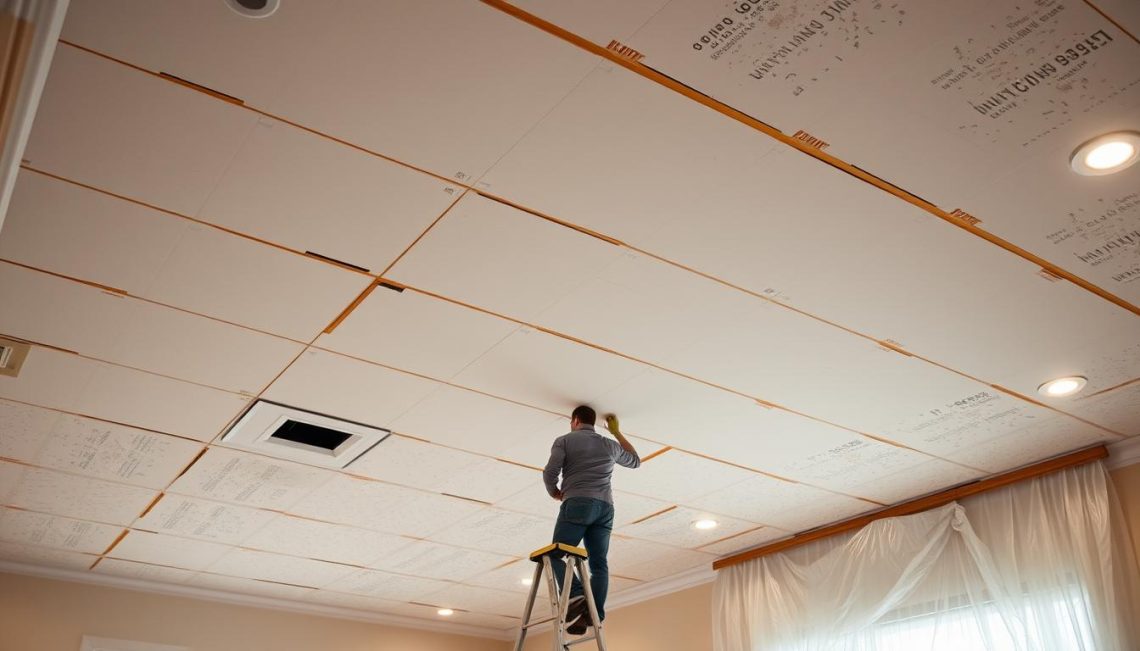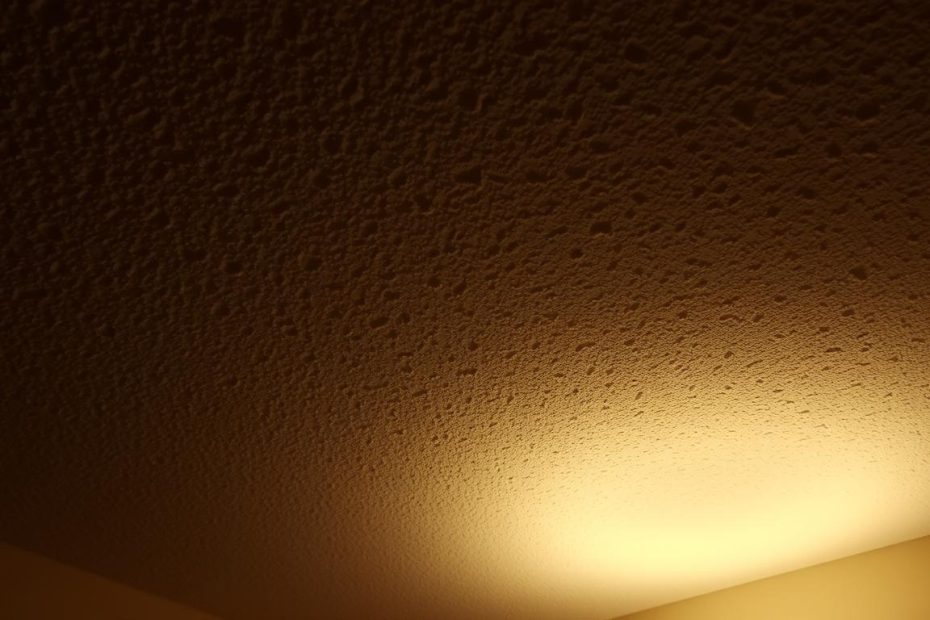Many homeowners face challenges with outdated popcorn ceilings, which were once a popular design choice. We understand that removing these ceilings can be a messy and costly endeavor. Fortunately, there are effective solutions for covering them without removal.
Covering a popcorn ceiling can be a cost-effective and less messy solution, allowing homeowners to avoid disturbing potential asbestos and reducing renovation time. We will outline the benefits and provide a comprehensive guide to empower homeowners in making informed decisions about their ceiling renovation projects.
Understanding Popcorn Ceiling Challenges
The challenges associated with popcorn ceilings are multifaceted, affecting both the aesthetic and practical aspects of home maintenance. Homeowners often struggle with the outdated look of these ceilings, as well as the difficulties in cleaning and maintaining them.
Aesthetic and Practical Issues
Popcorn ceilings can make a room look dated and are often difficult to clean, which can lead to a buildup of dust and dirt. This not only affects the appearance but also potentially exacerbates respiratory issues. When considering a DIY ceiling project, it’s essential to address these aesthetic and practical concerns.
Why Covering Is Better Than Removal
Covering a popcorn ceiling is often preferred over removal due to the potential for asbestos exposure and the mess associated with removal. By covering, homeowners can achieve a modern look without the hassle and cost of removal, making it a more appealing DIY ceiling solution.
| Consideration | Removal | Covering |
|---|---|---|
| Mess and Disruption | High | Low |
| Asbestos Exposure Risk | High | Low |
| Cost | High | Moderate to Low |
Ways To Cover A Popcorn Ceiling Without Removing It
Popcorn ceilings can be a challenge to deal with, but there are several effective ways to cover them without removal. Covering a popcorn ceiling is a cost-effective and less messy alternative to removal, and it can completely transform the look and feel of a room.
Ceiling Panels and Planks
Ceiling panels and planks are a popular choice for covering popcorn ceilings. They offer a modern and sleek appearance, and their installation is relatively straightforward.
Installation Process
The installation process involves measuring the ceiling, cutting the panels to size, and securing them to the ceiling using adhesive or nails.
Cost and Difficulty Level
The cost of ceiling panels and planks varies depending on the material, ranging from affordable options like PVC to more expensive choices like wood. The difficulty level is generally moderate, suitable for DIY enthusiasts with some experience.
Drywall Installation Method
Installing drywall over a popcorn ceiling provides a smooth finish and can be a more permanent solution. It requires careful planning and execution.
Tools and Materials Needed
To install drywall, you’ll need drywall sheets, joint compound, tape, and screws. Ensuring you have the right tools, such as a drill and a putty knife, is also crucial.
Step-by-Step Process
The process involves measuring and cutting the drywall to fit, securing it to the ceiling with screws, and finishing the seams with joint compound and tape.

Decorative Ceiling Tiles
Decorative ceiling tiles are another option for covering popcorn ceilings, offering a range of styles and designs to suit different decor.
Types of Tiles Available
From simple, plain tiles to more elaborate designs, there’s a wide variety of decorative ceiling tiles available, made from materials like PVC, metal, and wood.
Application Methods
Applying decorative ceiling tiles typically involves adhesive or a drop ceiling grid system, making it a relatively easy DIY project.
Fabric and Canvas Solutions
For a more unique look, fabric and canvas can be used to cover popcorn ceilings, adding texture and visual interest to a room.
Selecting Appropriate Fabrics
Choosing the right fabric involves considering factors like durability, texture, and how it complements the room’s decor.
Installation Techniques
Installation techniques vary, from stapling fabric to a frame that fits the ceiling to using adhesive directly on the ceiling.
Skim Coating Your Ceiling
Skim coating is a technique that involves applying a thin layer of joint compound over the popcorn ceiling to create a smooth surface.
Required Materials
The primary material needed is joint compound, along with a putty knife for application.
Application Process
The application process involves spreading the joint compound evenly over the ceiling, allowing it to dry, and then sanding it down to a smooth finish.
Each of these methods offers a different set of benefits and challenges. By considering factors like cost, difficulty, and the desired outcome, homeowners can choose the best method for their ceiling renovation or transformation project.
Preparing Your Space for Ceiling Transformation
A well-prepared space is crucial for a smooth ceiling covering process. Before you start your project, there are several steps to take to ensure a successful transformation.
Assessing Structural Integrity
It’s vital to assess the structural integrity of your ceiling to ensure it can support the weight of the new covering. This involves checking for any signs of damage or weakness.
Testing for Asbestos Safety
For ceilings built before the 1980s, testing for asbestos is a critical safety precaution. Asbestos can pose serious health risks if disturbed during the transformation process.
Room Preparation Checklist
Creating a checklist can help you prepare your room efficiently. This includes covering floors and furniture, turning off electrical supplies, and ensuring access to the ceiling area.
DIY vs. Professional Installation Considerations
Deciding whether to undertake the project yourself or hire a professional depends on several factors, including the complexity of the job and your level of expertise.
| Consideration | DIY | Professional |
|---|---|---|
| Cost | Lower upfront cost | Higher cost due to labor |
| Expertise | Requires personal DIY skills | Brings professional expertise |
| Time | Time-consuming | Saves personal time |
Selecting the Best Solution for Your Home
Now that we’ve explored various ways to cover a popcorn ceiling, it’s time to choose the best solution for your home. We recommend considering factors such as cost, ease of installation, and aesthetic appeal to make an informed decision.
When evaluating your options, think about your budget and the level of complexity you’re comfortable with. For instance, ceiling panels and planks offer a modern look, while decorative ceiling tiles provide a stylish and easy-to-install solution.
Ultimately, the right choice depends on your specific needs and preferences. By weighing the pros and cons of each method, you can transform your ceiling and enhance your living space.
